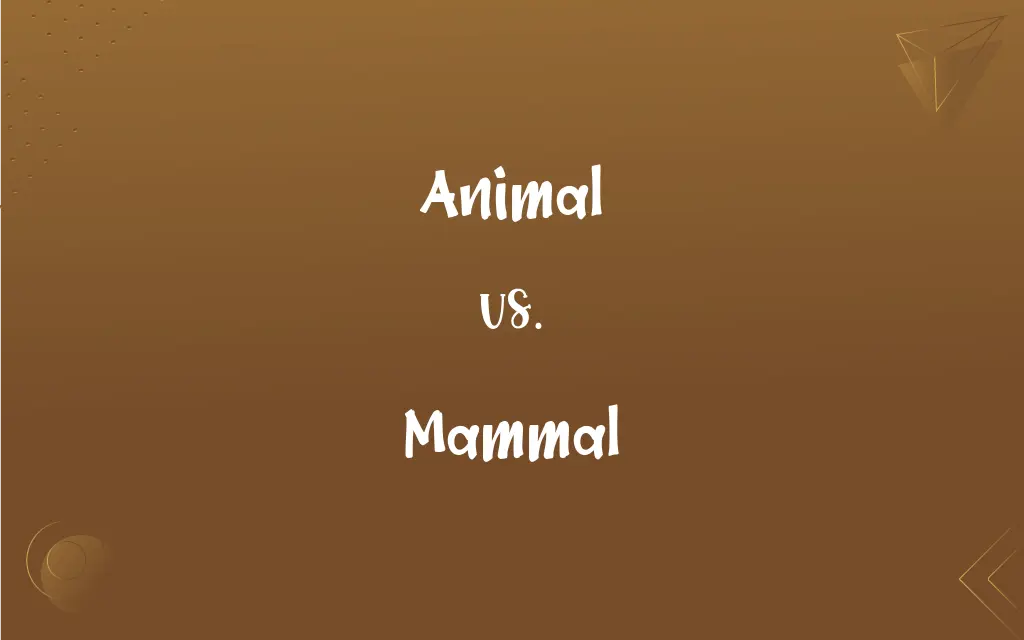Animal vs. Mammal: What's the Difference?
Edited by Janet White || By Harlon Moss || Updated on October 18, 2023
All animals are living organisms, while mammals are a specific class of warm-blooded animals with hair and mammary glands.

Key Differences
Animals encompass a vast kingdom of multicellular eukaryotic organisms. This kingdom is diverse, containing creatures from single-celled protozoa to complex beings like humans. Mammals, on the other hand, are a specific class within the animal kingdom.
In the realm of animals, you'll find creatures that reside in water, on land, and in the air, ranging from insects to reptiles to birds. Mammals are distinguished from these other animals primarily by characteristics like having hair or fur and bearing live young.
Another distinguishing feature is that animals reproduce in various ways – some lay eggs, others give birth to live offspring, and some reproduce asexually. Mammals exclusively give birth to live young (with a few exceptions like the monotremes which lay eggs) and possess mammary glands used to nourish their offspring.
Furthermore, the behavior and habitat of animals can be incredibly varied. Some animals are solitary, while others live in large groups or colonies. Mammals also exhibit a range of behaviors, but they typically have more advanced brain structures compared to other animals, allowing for higher cognitive functions and social structures.
When looking at lifespan, animals can have lifespans ranging from a few days to several years. Mammals tend to have longer lifespans compared to many other animals, and they also tend to care for their young for extended periods.
ADVERTISEMENT
Comparison Chart
Classification
Kingdom
Class within Animal Kingdom
Reproduction
Varies (e.g., egg-laying, live birth)
Typically live birth (exceptions like monotremes)
Physical Features
Varies widely (e.g., scales, feathers)
Hair/fur, mammary glands
Temperature
Cold-blooded or warm-blooded
Warm-blooded
Habitat
Land, water, air
Primarily land (exceptions like whales and dolphins)
ADVERTISEMENT
Animal and Mammal Definitions
Animal
A sentient being as opposed to plants or inanimate objects.
Humans are animals with a unique ability to reason.
Mammal
A member of the class Mammalia within the animal kingdom.
Kangaroos are unique mammals native to Australia.
Animal
A multicellular organism that can move and respond to its environment.
The animal scurried away when it sensed danger.
Mammal
An animal that usually gives birth to live young.
Unlike birds, the mammal doesn't lay eggs.
Animal
Any living organism classified under the kingdom Animalia.
A wide variety of animals inhabit the rainforest.
Mammal
An animal with three middle ear bones.
This mammal's hearing is aided by its unique ear structure.
Animal
A creature that consumes organic material for sustenance.
The animal hunted its prey with precision.
Mammal
A warm-blooded vertebrate with hair and mammary glands.
The mammal nursed its young with milk.
Animal
An organism that is capable of independent movement.
The animal roamed the plains searching for food.
Mammal
A creature possessing a neocortex in its brain.
The mammal's advanced brain allows for complex behaviors.
Animal
Any of numerous multicellular eukaryotic organisms of the kingdom Metazoa (or Animalia) that ingest food rather than manufacturing it themselves and are usually able to move about during at least part of their life cycle. Sponges, jellyfishes, flatworms, mollusks, arthropods, and vertebrates are animals.
Mammal
Any of various warm-blooded vertebrate animals of the class Mammalia, including humans, characterized by a covering of hair on the skin and, in the female, milk-producing mammary glands for nourishing the young.
Animal
An animal organism other than a human, especially a mammal.
Mammal
An animal of the class Mammalia, characterized by being warm-blooded, having hair and producing milk with which to feed its young.
Mammal
(paleontology) A vertebrate with three bones in the inner ear and one in the jaw.
Mammal
One of the Mammalia.
Mammal
Any warm-blooded vertebrate having the skin more or less covered with hair; young are born alive except for the small subclass of monotremes and nourished with milk
FAQs
Are all mammals animals?
Yes, all mammals are animals, but not all animals are mammals.
What are the main characteristics of mammals?
Mammals have hair, mammary glands, and typically give birth to live young.
Do animals have a backbone?
Some animals, called vertebrates, have backbones, while others, called invertebrates, do not.
What is an animal?
An animal is a multicellular, eukaryotic organism belonging to the kingdom Animalia.
Are birds considered animals or mammals?
Birds are animals, but they are not mammals; they belong to the class Aves.
Why do mammals have hair or fur?
Hair or fur provides mammals with insulation, protection, and sensory functions.
What differentiates animals from plants?
Animals are capable of independent movement and have sensory responses, while plants don't.
Which animals lay eggs?
Many animals lay eggs, including birds, reptiles, amphibians, and some mammals like monotremes.
Do all mammals live on land?
No, some mammals, like whales and dolphins, live in water.
How do animals reproduce?
Animals reproduce in various ways, including egg-laying, live birth, and asexual reproduction.
What distinguishes mammals from reptiles?
Mammals have hair and mammary glands, while reptiles have scales and typically lay eggs.
Can animals be herbivores, carnivores, or omnivores?
Yes, animals can have varied diets including plants, meat, or both.
Do all mammals have teeth?
Most mammals have teeth, but some, like the anteater, do not.
Why are mammals warm-blooded?
Being warm-blooded allows mammals to maintain a consistent body temperature, which supports high metabolic rates and active lifestyles.
Are whales mammals or fish?
Whales are mammals, not fish.
How many animal species exist?
There are over a million known animal species, with many more yet to be discovered.
Are humans animals?
Yes, humans are animals, specifically mammals, belonging to the species Homo sapiens.
Are insects animals?
Yes, insects are animals belonging to the class Insecta.
What's the smallest mammal?
The bumblebee bat is often considered the smallest mammal by length, while the Etruscan shrew is the lightest.
How do mammals breathe?
Most mammals breathe using lungs.
About Author
Written by
Harlon MossHarlon is a seasoned quality moderator and accomplished content writer for Difference Wiki. An alumnus of the prestigious University of California, he earned his degree in Computer Science. Leveraging his academic background, Harlon brings a meticulous and informed perspective to his work, ensuring content accuracy and excellence.
Edited by
Janet WhiteJanet White has been an esteemed writer and blogger for Difference Wiki. Holding a Master's degree in Science and Medical Journalism from the prestigious Boston University, she has consistently demonstrated her expertise and passion for her field. When she's not immersed in her work, Janet relishes her time exercising, delving into a good book, and cherishing moments with friends and family.































































